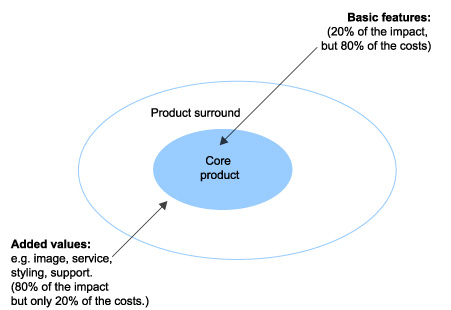
Elements of The importance of added values:
The core product and the product surround accounting for the combined product value.
Principle:
Identifies the role of added values to the basic features of the brand, which are created via elements of the marketing mix such as packaging, price, style of advertising or means of distribution
A brand’s positioning is always relative to other brands in the same market segment. In order to identify a relevant position for the brand, the following factors are taken into account:
- The target market and their desired benefits from the brand
- Competitor brands and their respective positions
- Points of similarity and difference between the firm’s brand and the competition.
Issues:
Authenticity:, Risk reduction:, Communication device:
A product is the problem-solver that provides solutions to the consumer’s needs or wants, brands also deliver intangible or more emotive rewards. These may relate to psychological or social reward such as status, image or prestige.
Levitt (1980) core product is the ‘fundamental’ and ‘rudimentary’ offer or benefit provided to the customer.
Interbrand’s John Murphy elements must similarly meet the tests of appropriateness, appeal, and differentiation
- Functional risk: The product does not perform up to expectations
- Physical risk: The product poses a threat to the physical well-being or health of the user or others
- Financial risk: The product is not worth the price paid
- Social Risk: The product results in embarrassment from others
- Psychological risk: The product affects the mental well-being of the user
- Time risk: the failure of the product results in an opportunity cost of finding another satisfactory product
Applications:
To build a stronger product surround, to achieve a stronger brand differentiation.
Source of The importance of added values:
Henley Business School
Related Models & Sources:
Levitt (1980) presents a model of four evolving levels of a product over its core benefit: generic, expected, augmented and potential
Kotler (2005) defines five levels to a product: 1 core benefit level, 2 generic product level, 3 expected product level, 4 augmented product level, 5 potential product level
Trout and Ries (1972, 2001) first referred to brand positioning as taking place in the consumer’s mind. Building up effective perceptions and images of the brand in the consumer’s mind is central to the development of effective brand meaning and knowledge within the customer franchise.






